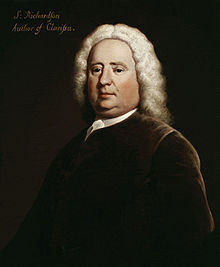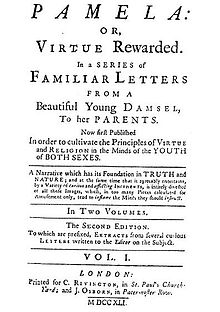Samuel Richardson

Samuel Richardson (born August 19, 1689 in Mackworth , Derbyshire , England , † July 4, 1761 in London ) was a British writer who is best known for his sensitive novels of virtue.
Life
Richardson was born the son of a carpenter and first learned the profession of printer. He was already very successful as a printer and publisher and became a print shop owner in London when, at the age of 50, in 1740, he was commissioned to compose a collection of sample letters for young women. The work on this letter holder , which was finally published in 1741 under the title Familiar Letters , inspired Richardson to write a letter novel .
The work entitled Pamela or Rewarded Virtue from 1740, in which a virtuous maid has to defend herself against the coarse and brutal harassment of her master, finally converts her morally depraved master, and then lets him marry her, was instantaneous a big success. The novel not only founded the genre of the sensitive novel, of which Goethe Werther is one of the best-known German examples , but was also one of the groundbreaking works in the history of the novel, as here for the first time a subjective voice consistently displaced the omniscient narrator.
The work also founded the school of sensitive literature . Opposition to this kind of sensitivity soon developed, for example in Henry Fielding's parody Shamela (1741), which denounced the book's moral hypocrisy and uptight ambiguities. However, this did not affect the success of Richardson's novel. Richardson revised Pamela (1739/40) for a total of 22 years (1739–1761) , always keeping an eye on the tone and aesthetics of the progression of the era. He therefore not only marked its beginning, but also wrote its development in literary history.
His next book, Clarissa or, The History of a Young Lady (1748) sold even better than Pamela - even though it consisted of 547 letters and was over a million words long, making it the longest novel of its time. Consequently, contemporary authors were also attracted to a detailed review, for example by Henry Fielding's sister Sarah Fielding ( Remarks on Clarissa. 1749 ), who remained well-disposed to Richardson despite her brother's satirical criticism. Richardson's third epistolary novel, Sir Charles Grandison (1753), unlike its two predecessors, placed a man in the center of the plot, and a good man too. If Pamela and Clarissa were constantly victims of wicked, lustful men, Richardson sketches the ideal Christian gentleman in his last novel in Sir Charles Grandison. Even this novel, although it was slightly longer than Clarissa , was a great success. Jean-Jacques Rousseau built on Richardson's successes with his Julie or Die neue Heloise of 1761.
In Germany too, Richardson's letter novels were widely read and exerted influence. Such was Sir Charles Grandison Cornelia Goethe's favorite book because they identified with the figure of Harriet Byron. Christian Fürchtegott Gellert made the first attempt at a German letter novel with the book Life of the Swedish Countess von G *** (1750). The story of Fräuleins von Sternheim (1771) by Sophie von La Roche was an enormous success . This story of a fallen girl or young lady, based on Richardson, was important as a model for Goethe's The Sorrows of Young Werther (1774). Production German epistolary novel ripped the sensibility not turned away, but gave up in the time of the Weimar Classics : Friedrich Schiller's sister Caroline of Wolzogen published in 1797 (anonymously) her novel Agnes von Lilien , the many elements of Richardson's novels recorded and temporarily Schiller or Was attributed to Goethe. Richardson's novels Pamela and Clarissa also had a great influence on German bourgeois tragedy in its early, sensitive phase, for example in Lessing's Miss Sara Sampson (1755) or Pfeil's Lucie Woodvil (1756).
Even if Richardson's novels only appeal to a few readers today, their significance in literary history was enormous. The French philosopher and author Denis Diderot was also an admirer of his works, such as the novels Pamela, or Virtue Rewarded (1740) and Clarissa (1748). In Diderot's book Éloge de Richardson (1760), he praised Richardson's attention to detail with regard to everyday things and because he succeeded in depicting moral issues in a vivid and exciting way in the everyday events of his fellow men. Also, his novels made the reader forget that it was a fiction .
For the first time in a novel, he focused entirely on the characters' internal drama rather than on the external plot, and for the first time he designed a detailed psychogram of a female main character. Richardson was thus groundbreaking for later authors such as Jane Austen , Henry James , the Brontë siblings , Thomas Hardy and even for John Cleland and DH Lawrence .
Intertextual references
In his introduction to his story A Magnanimous Plot , Friedrich Schiller explicitly refers to the two texts "Sir Charles Grandison" and "Pamela or the rewarded virtue" and hopes that his text will leave the reader warmer.
Works (selection)
- Pamela or, Virtue Rewarded . (1740)
-
Clarissa or, The History of a Young Lady . (1747/48)
- German: Clarissa, The story of an elegant woman, edited by the person who delivered the story of Pamela, translation by Johann David Michaelis, 7 vols., Vandenhoeck, Göttingen 1748–1753
- Vol. 1 ( digitized version and full text in the German text archive )
- Vol. 2 ( digitized version and full text in the German text archive )
- Vol. 3 ( digitized version and full text in the German text archive )
- Vol. 4 ( digitized version and full text in the German text archive )
- Vol. 5 ( digitized version and full text in the German text archive )
- Vol. 6 ( digitized version and full text in the German text archive )
- Vol. 7 ( digitized version and full text in the German text archive )
- Vol. 8: Supplement ( digitized version and full text in the German text archive )
- German: Clarissa, The story of an elegant woman, edited by the person who delivered the story of Pamela, translation by Johann David Michaelis, 7 vols., Vandenhoeck, Göttingen 1748–1753
-
The History of Sir Charles Grandison. (1753/54)
- German: History of Mr. Carl Grandison. In letters drafted by the author of Pamela and Clarissa, translation a. a. by Christian Fürchtegott Gellert and Abraham Gotthelf Kästner , 7 vols., Weidmann, Leipzig 1754/55
Illustrations
The first German illustrated edition of Charles Grandison was created in 1756. Philipp Erasmus Reich , publishing manager at the Weidmann bookstore, traveled from Leipzig to Richardson in London to coordinate the subjects of the illustrations with him. Reich was able to win the French artist Charles Eisen over for the drawings . The depictions were engraved in copper by Johann Martin Bernigeroth . The series was finally completed by Gottfried Eichler . As usual, the frontizspiz and the 21 engravings were also sold separately.
Film adaptations
- 1974 - British film by Jim O'Connolly: Mistress Pamela [1] based on his novel Pamela with Ann Michelle as Pamela Andrews and Julian Barnes as Lord Robert Devenish (Mr. B)
- 1991 - British TV series by Robert Bierman (BBC): Clarissa [2] based on his novel Clarissa with Saskia Wickham as Clarissa and Sean Bean as Robert Lovelace
- 2003 - Italian telenovela by Cinzia TH Torrini: Elisa or Elisa di Rivombrosa. The popular telenovela Elisa di Rivombrosa was freely narrated from the novel Pamela. The story takes place in Turin in the second half of the 18th century. The role of Pamela is that of Elisa Scalzi (played by Vittoria Puccini ) in the telenovela. The role of Mr. B is that of Count Fabrizio Ristori (played by Alessandro Preziosi ).
literature
- Astrid Krake: "How art produces art" .: Samuel Richardson's "Clarissa" in the mirror of her German translations (= Münster monographs on English literature. Vol. 23). Lang, Frankfurt am Main et al. 2000, ISBN 3-631-36432-6 ( review in: TRANSST. NS Vol. 35, May 2001 ).
Web links
- Literature by and about Samuel Richardson in the catalog of the German National Library
- Works by and about Samuel Richardson in the German Digital Library
Individual evidence
- ↑ http://www.gutenberg.org/ebooks/27744
- ↑ See: Ulrike Prokop: The Illusion of the Great Couple. Volume 2: The diary of Cornelia Goethe (= Fischer 7420 Fischer Wissenschaft ). Fischer-Taschenbuch-Verlag, Frankfurt am Main 1991, ISBN 3-596-27420-6 , p. 209.
- ↑ On participation in the translation cf. John F. Reynolds (ed.): CF Gellerts Briefwechsel, Vol. I (1740–1755), Berlin, New York 1983, p. 369, digitized
- ↑ See Philippe Kaenel: Illustration, in: Michel Delon: Encyclopedia of Enlightment, Vol. I, AL, London, New York 2001, pp. 686-690, here p. 690, digitized .
| personal data | |
|---|---|
| SURNAME | Richardson, Samuel |
| BRIEF DESCRIPTION | English writer |
| DATE OF BIRTH | August 19, 1689 |
| PLACE OF BIRTH | Mackworth , Derbyshire , England |
| DATE OF DEATH | 4th July 1761 |
| Place of death | London |


